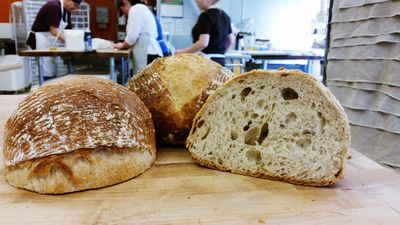
This is the second post in a series of photo essays about how we bake at Orange Boot Bakery. Today, Saskatchewan Sourdough.
Ingredients for Saskatchewan Sourdough
- Organic Unbleached Wheat Flour
- Organic Whole Wheat Flour
- Water
- Salt
- Yeast
If Mark is our Shakespeare, and the Birdseed our Hamlet, then the Saskatchewan Sourdough is our Midsummer Night's Dream. Born of love, passion, and the desire to make a totally awesome sourdough that appeals to everyone, our Sourdough joins the Birdseed as the foundation of everything delicious. As Hemingway put pen to paper, Picasso put brush to canvas, and Michelangelo put chisel to stone, we join Mark as he begins the long, arduous ritual that crafts our Saskatchewan Sourdough.
Day 1: Scale and Mix Levain
Similar to the Birdseed, the Sourdough has humble beginnings. The flour, salt, and yeast are scaled into a big dough tub, and left until morning. Since there are so few ingredients compared to loaves like the Birdseed or Walnut Raisin, this is quite an easy process. Once the starter has been fed and the ingredients left to rest, there is nothing left to do but wait!
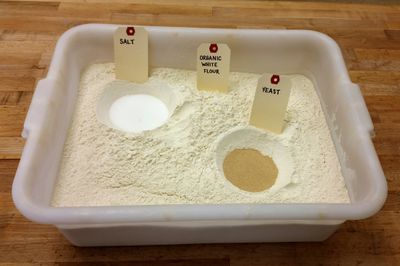
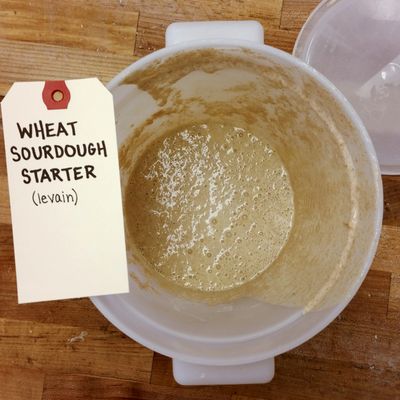
Day 2: Mix, Shape, Bake
When Mark walks in to work in the morning, the bakery is a desolate sight. The sun won't rise for another 3 hours at least, it's usually raining or snowing, he hasn't had breakfast yet, and he's greeted by a mountain of dough tubs as tall as he is. Less than ideal by most standards, but this is just how Mark likes it. With Bob Dylan's "Desolation Row" playing, he finds an apron, grabs a tub, and listens to Cindy mutter something about slowly going insane after listening to Bob Dylan every single morning for 5 years straight.
As usual, the Sourdough begins its day in the mixer, where the flour, salt, and a tiny amount of yeast are combined with water and the perfectly ripe sourdough starter. A relatively simple process, but essential to develop the strength of the gluten so the loaf doesn't collapse on itself. When the Mixer of Mastery has successfully mashed all the ingredients together, the dough returns to the tub before it gets divided and shaped. After being mixed, the dough rests for a full hour before being divided. Combined with all the other rest periods the dough receives, this allows the dough to ferment and really develop it's flavour. A really tangy San Francisco-esque sourdough would ferment for much longer, but since we want a milder sourdough flavour we ferment the dough for less time.
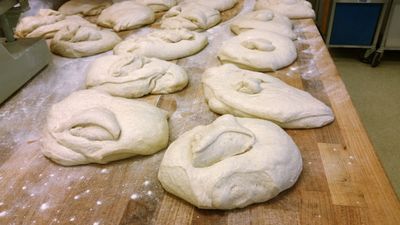
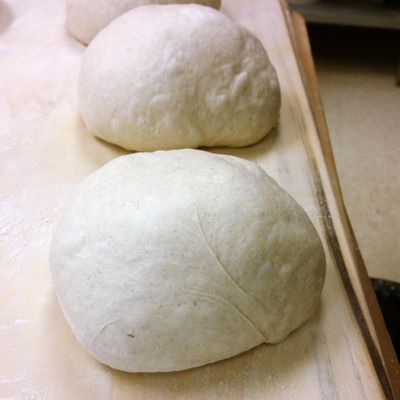
With the easiest part behind him, our gluten-loving Michelangedough brings out the scale and proof boards to begin chopping up the massive slab of dough. Each loaf gets a rough divide and a pre-shape into a boule before resting for around half an hour on the proof boards. The rest allows the dough to relax for a little bit, which makes it it more pliable when Mark shapes them a second time.
These large boules resemble almost every other loaf we make at this point, but that will quickly change! Whether through laziness or the fact that basically every other loaf is some variant of a rectangle, the Sourdough is destined to remain a round loaf. That doesn't mean that it is exempt from a second shape, but it makes things a little bit easier for our hero!
Mark effortlessly stretches, folds, and rounds each loaf with an ease that suggests he could do one in each hand, provided his were as large as Shaq's. (Un)fortunately he isn't Shaq, so he's forced to round them one at a time, laying each to rest upside down in a woven basket coated in flour. The baskets replace the couche cloths used with the other loaves, and they give the Sourdough the nice flour pattern when they are baked. When all the loaves are in baskets, they rest for another hour at least. All this resting is really time consuming, but it lets the loaves ferment more and develop that tangy, sourdough flavour we all love. Once all the loaves are basket-ified and rested, there's only one thing left to do: bake them!
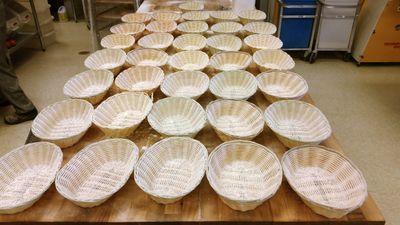
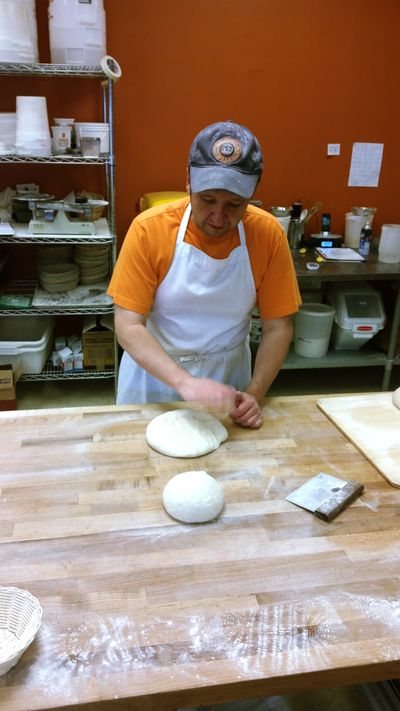
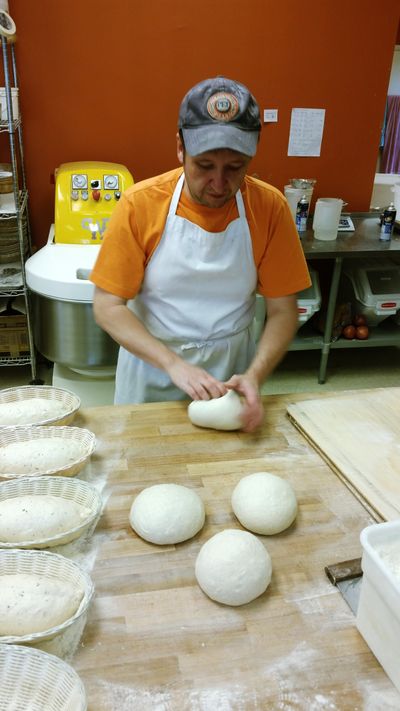
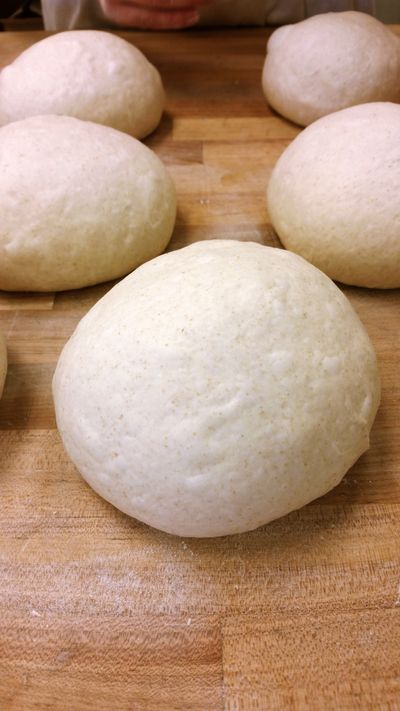
The most exciting part of each loaf's brief history, scoring and loading is one of the most important steps as well! Each loaf is removed from its basket and flipped so that it is right side up, showing off the beautiful lines of flour left from the basket. Each loaf is scored once to control it's burst, then Mark gracefully shoves them into the oven to bake!
The pattern from the baskets will give the loaf a much more interesting appearance than just slashing it could, which is complemented by the lack of seeds or other attention-grabbing ingredients. A loaf with a large number of seeds, nuts, and other distinct ingredients creates a very busy looking loaf, which can obscure the finer details in each loaf. Conversely, an extremely minimalist loaf doesn't command enough attention, and can often get overlooked. Some say that bread isn't art; we think they're dead wrong.
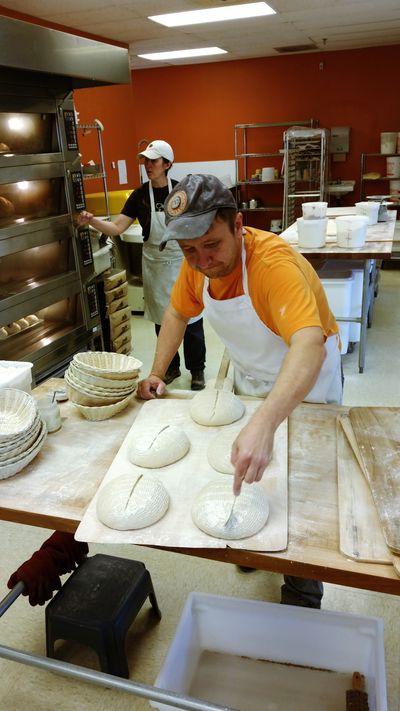

Once the loaves are baked, they are carefully pulled from the raging inferno onto our shelves for us to sell! The Saskatchewan Sourdough is one of our favourite loaves, and also one of our most versatile. Not sure what to do with it? Check out some ideas below!
GARLIC TOAST
- 1 Saskatchewan Sourdough, sliced
- 2-4 cloves of garlic, minced
- 1/2 cup (ish) of soft butter
Preheat oven to 375, and combine the garlic and butter in a small bowl. Spread the butter on the Sourdough, set on a pan, and toast in the oven until golden brown.